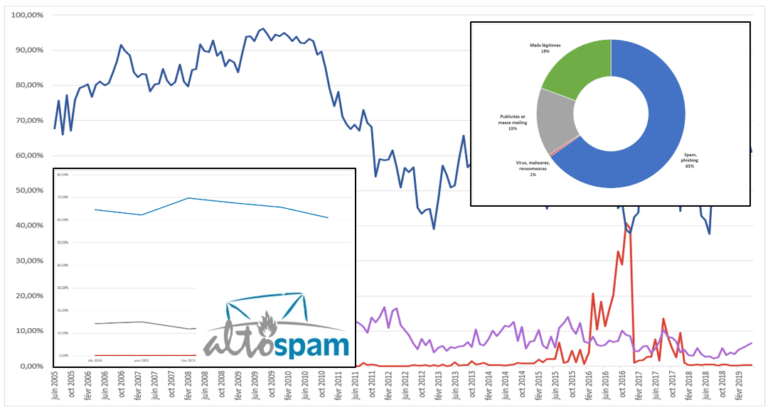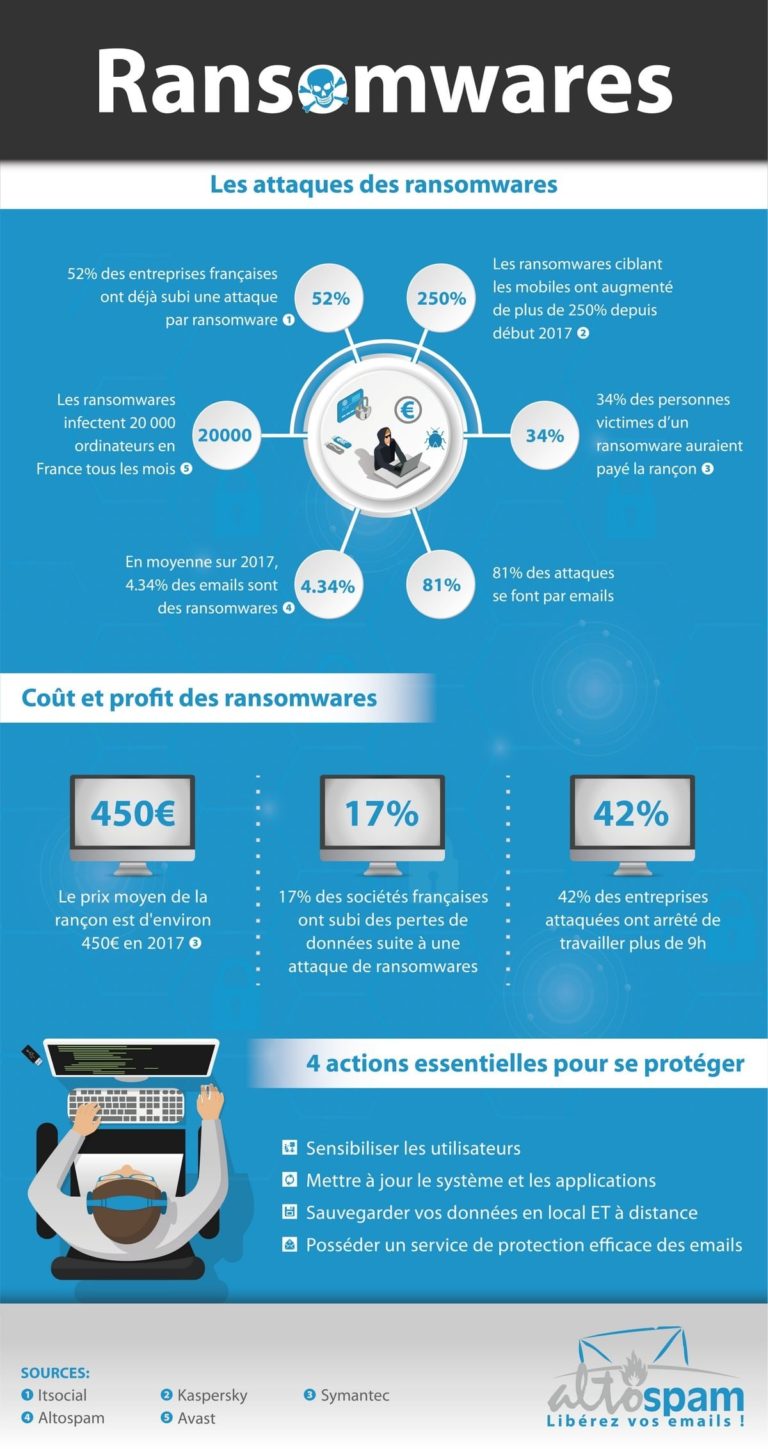Mailsafe our anti-ransomware solution for your business
Our Mailsafe solution blocks ransomware before it reaches your inbox

The receipt of malicious e-mails is the starting point for over 90% of targeted attacks. Ransomware is a specific form of malware that aims to encrypt a system’s sensitive data or lock it down completely, preventing access to files or system functionality. Once the data has been encrypted or the system locked, the attackers demand a ransom to provide the decryption key or solution to restore access to the data or system. Ransomware is primarily motivated by financial gain. It can be propagated via phishing e-mails, compromised websites, malicious downloads and software vulnerabilities.
A ransomware attack almost always involves a worm infecting a system, enabling the ransomware itself (too easily detected if delivered directly) to be downloaded and installed.
What is polymorphic malware?
The most advanced malware possesses the ability to adapt to its environment, enabling it to remain dormant, modify its code and even transform itself into new forms. Polymorphic malware is capable of modifying its code and characteristics with each infection. Unlike traditional malware, which uses static malicious code, polymorphic malware uses transformation techniques to metamorphose and evade detection by conventional security software. This makes them particularly dangerous and difficult to detect.
When a computer system is infected by polymorphic malware, it modifies itself by creating variants with different signatures and fingerprints. Each copy of the malware can therefore have a different appearance, making it more difficult for traditional antivirus software to recognize and detect it. These transformations are carried out automatically by the malware each time it propagates or executes.
Our Mailsafe solution offers protection against the most sophisticated malware and ransomware. With our anti-malware and anti-ransomware solution, you can effectively block these advanced threats.
There are a variety of ransomware strains, each with its own degree of sophistication and dangerousness. Among the best-known ransomwares considered the most dangerous are Ryuk, Locky, Emotet, Cryptowall, Petya and Cerber. All these strains trigger the display of a ransom note on the user’s screen when executed. This demand usually includes a threatening message and instructions on how to make payment.

How does Mailsafe protect your business from sophisticated ransomware attacks?
Our solution effectively blocks both known and unknown threats. Altospam’s Mailsafe anti-malware and anti-ransomware solution relies on proprietary technology based on AI and machine learning to detect malicious messages and behavior. Altospam helps you prevent email-borne ransomware while protecting email systems and users from downtime and data loss. Mailsafe combines behavioral analysis with continuous, automated inspection of links and attachments to anticipate and prevent future attacks and new threats.
Altospam’s email ransomware protection relies on sophisticated detection engines to identify threats and stop them before they execute.
Heuristic and behavioral analysis are used to detect and identify e-mails containing known or unknown (polymorphic) ransomware. By combining heuristic analysis and behavioral analysis (Machine Learning), Altospam’s Mailsafe detects ransomware more effectively. Heuristic analysis looks for specific indicators and known patterns, while behavioral analysis is able to detect ransomware based on its malicious behavior, even if it uses evasion techniques or polymorphic code to mask its presence. This combination offers enhanced protection against new ransomware variants, and contributes to strengthening the security of IT systems.
Heuristic analysis
Heuristic analysis involves examining e-mails and attachments using a set of predefined rules. These rules are designed to detect potentially malicious patterns, behaviors or features (looking for anomalies such as executable files, suspicious code, macros or malicious URLs). For example, they can search for specific keywords associated with ransomware, suspicious file formats or malicious scripts. Heuristic analysis is continually improved and updated to take account of new ransomware variants and evasion techniques.
Behavioral analysis
Behavioral analysis uses machine learning-based techniques to examine the behavior of e-mails and attachments. It looks for anomalies and patterns of malicious behavior, rather than focusing on specific ransomware signatures. Behavioral analysis is able to detect new ransomware variants and adaptations of their code, as it focuses on malicious actions and behaviors rather than the specific characteristics of known malware.
Mailsafe also protects against the following threats
Anti-phishing
Our machine learning algorithms perform behavioral, contextual and visual analyses of emails and urls to identify phishing attacks.
Anti- Spear-phishing
Our anomaly detection and semantic analysis algorithms detect spoofing attempts and malicious patterns in phishing emails.
Anti-malware | Anti-virus
Our solution integrates 6 antivirus tools to complement anti-spam filters, as well as 4 innovative technologies to detect unknown viruses.
Anti-spam
Our solution blocks spam before it reaches your mail server, and before it reaches your employees’ mailboxes. Mailsafe combats false positives and ensures a near-zero false-positive rate.
Thousands of CIOs, CISOs and IT managers have already chosen Altospam
New and increasingly sophisticated ransomware attacks are being launched by hackers. Our Mailsafe solution detects and blocks phishing, spear-phishing, malware, viruses, ransomware and spam threats in real time.

Free trial
15-day free trial: test our email protection solutions to find out about attempted intrusions into your mailboxes.

Book a demo
Our email protection solution helps you prevent threats from phishing, ransomware, spear phishing, malware, spam and viruses. Book a slot with a cyber expert for a personalized demonstration.

Get a quote
Our rates are tailored to your business and your size. Ask us for a customized quote based on your company’s needs.
How can you protect your business email from ransomware?
-
How to combat polymorphic ransomware effectively?
To effectively combat polymorphic ransomware, which is capable of modifying its code according to its environment, here are a few key measures: :
- Advanced security solutions : Use security solutions like Mailsafe that incorporate advanced heuristic and behavioral analysis techniques. These solutions are designed to detect polymorphic ransomware by analyzing malicious behavior and suspicious activity patterns, rather than relying solely on specific signatures. They are able to detect unknown ransomware variants by focusing on their malicious behavior rather than on specific code features.
- Regular updates: Make sure you keep all operating systems, software and applications up-to-date by installing the latest security updates and patches. Polymorphic ransomware often exploits known vulnerabilities to penetrate systems. Regular updates help close these security loopholes and reduce the risk of ransomware infection.
- Awareness-raising and ongoing training: Raise employee awareness of ransomware threats on a regular basis, and provide training in IT security best practices. Users need to be aware of the risks associated with polymorphic ransomware and the social engineering techniques used to propagate it, to avoid risky behavior such as downloading attachments or opening suspicious links.
- Firewall and e-mail filtering: Configure and maintain a robust firewall to monitor network traffic and block unauthorized connections. Also use e-mail filters to detect and block malicious e-mails containing attachments or links infected with polymorphic ransomware.
- Regular backups and offline storage: Make regular backups of all critical data and store them offline or in a secure environment. In the event of infection by polymorphic ransomware, having up-to-date backups means you can restore data without having to pay the ransom.
- Proactive monitoring and detection: Implement tools for proactive monitoring and detection of abnormal activity on networks and systems. Behavioral analysis, Deep Packet Inspection (DPI) and the use of machine learning technologies can help identify behaviors characteristic of polymorphic ransomware and block them quickly.
By combining these measures, organizations can strengthen their resilience against polymorphic ransomware and reduce the risk of infection. It is also essential to maintain a proactive approach and keep up to date with the latest trends and techniques used by attackers.
-
Why is email the main channel for ransomware attacks?
E-mail is the main channel for ransomware attacks, for several reasons:
- Ubiquity: e-mail is a universal means of communication widely used in professional environments. This provides attackers with a vast potential attack surface.
- Social engineering: Ransomware attacks via e-mail often rely on social engineering techniques to deceive users. Attackers may pose as trusted entities, such as colleagues or financial institutions, to convince users to open infected attachments or click on malicious links.
- Malicious attachments: Phishing e-mails often contain attachments infected with ransomware. These attachments can be disguised in a variety of formats, such as Microsoft Office documents, PDF files or compressed archives, and may contain malicious scripts or macros that launch the infection once opened.
- Malicious links : Phishing e-mails can also contain links to malicious websites that automatically download ransomware onto the victim’s computer. These links may be disguised as legitimate content, making them difficult for users to detect.
- Mass distribution: Attackers may send phishing e-mails containing ransomware to many people at the same time, in the hope that a certain number will fall into the trap. This mass distribution approach increases the attack’s chances of success.
- Evasion techniques: Attackers use evasion techniques to bypass traditional security measures. This includes the use of obfuscated or polymorphic code to evade detection by e-mail filters and antivirus software, making ransomware more difficult to detect.
Appropriate protective measures, such as e-mail filtering solutions like Mailsafe, advanced security solutions and regular user awareness, are therefore essential to mitigate the risks associated with e-mail-distributed ransomware.
-
What are the consequences of a ransomware attack?
Ransomware is the most costly form of cyberattack for businesses, due to the financial and operational consequences it entails. Here are some of the consequences:
- Data encryption : Ransomware is designed to encrypt sensitive data and business-critical files, making them impossible to access without the appropriate decryption key. This can paralyze business operations, prevent access to vital information and cause major disruption.
- Ransom demand: Attackers usually demand a ransom to provide the decryption key and restore access to data. The amount of the ransom can vary considerably, from a few hundred to several million dollars, depending on the size and value of the targeted company. Paying the ransom can have a significant financial impact on the company, and does not always guarantee full data recovery.
- Business disruption: Ransomware can cause major disruption to business operations, resulting in lost productivity and delays in service delivery. IT systems may be inaccessible for an extended period, which can have a negative impact on customer satisfaction, business partnerships and corporate reputation.
- Remediation costs: Remediation after a ransomware attack can entail considerable costs. This can include hiring IT security specialists to assess and repair compromised systems, investing in additional security solutions, recovering data from backups, as well as notifying affected parties and taking the necessary compliance measures.
- Data loss: In some cases, even after the ransom has been paid, there is no guarantee that data will be fully recovered. Attackers may not keep their promise, or data may be damaged in the decryption process. This can result in the permanent loss of valuable data, such as customer information, financial data or intellectual property.
- Reputational impact: Ransomware attacks can also have a significant impact on a company’s reputation. Customers and business partners can lose confidence in the company due to compromised data and the inability to ensure their information is protected. This can lead to loss of customers, litigation and difficulties in rebuilding trust over the long term.
It is essential for companies to implement preventive measures, such as effective security solutions, regular data backups, employee awareness and training, and effective patch and update management to reduce the risks associated with ransomware.
-
How to choose an email protection solution against known and unknown ransomware?
When choosing an e-mail protection solution against known and unknown ransomware, here are some key points to consider:
- Advanced heuristic and behavioral analysis: Make sure your e-mail protection solution incorporates advanced heuristic and behavioral analysis techniques like Mailsafe. These techniques detect known and unknown ransomware by analyzing malicious behavior and suspicious activity patterns, rather than relying solely on specific signatures. This guarantees protection against ransomware variants that have not yet been identified.
- Artificial intelligence and machine learning: Check whether the solution uses artificial intelligence (AI) and machine learning technologies to improve ransomware detection. AI can help identify malicious patterns and behaviors in e-mails, while machine learning enables the solution to adapt and improve its detection capabilities over time.
- Integration with reputation databases: Ensure that the e-mail protection solution integrates with known reputation databases to detect known ransomware. These databases provide information on malicious files and links already listed, enabling known threats to be identified quickly.
- Proactive detection capability: Check whether the solution is capable of detecting suspicious behavior and precursory indicators of ransomware, even in the absence of specific signatures. Proactive detection enables you to anticipate new ransomware variants and block them before they can cause any damage.
- Link and attachment filtering: Make sure your e-mail protection solution offers effective filtering of malicious links and infected attachments. It should be able to scan attachments for malicious code, dangerous macros and other indicators of ransomware.
- Detailed reporting and analysis: Check whether the solution provides detailed reporting and analysis of ransomware attack attempts. This information is essential for assessing protection effectiveness, analyzing attack trends and taking corrective action.
- Ease of integration and administration: Make sure the e-mail protection solution is easy to integrate into your existing infrastructure and easy to administer. It should offer centralized management, regular updates and a user-friendly interface for easy configuration and monitoring.
It’s also advisable to read reviews and feedback from other users, request demonstrations and conduct product evaluations to make an informed decision. The chosen solution must meet your organization’s specific needs in terms of security, performance and compatibility with your IT environment.


